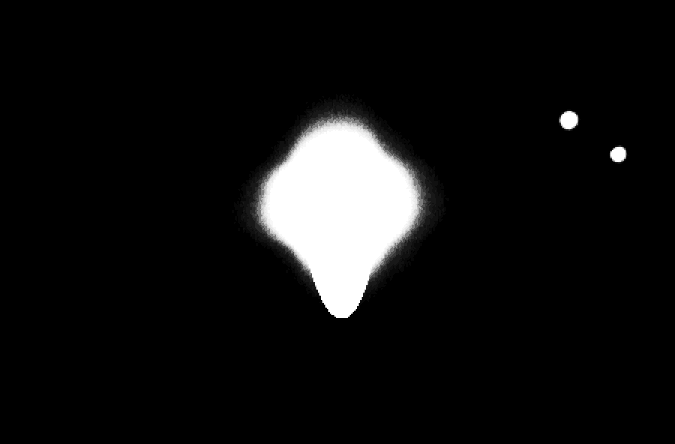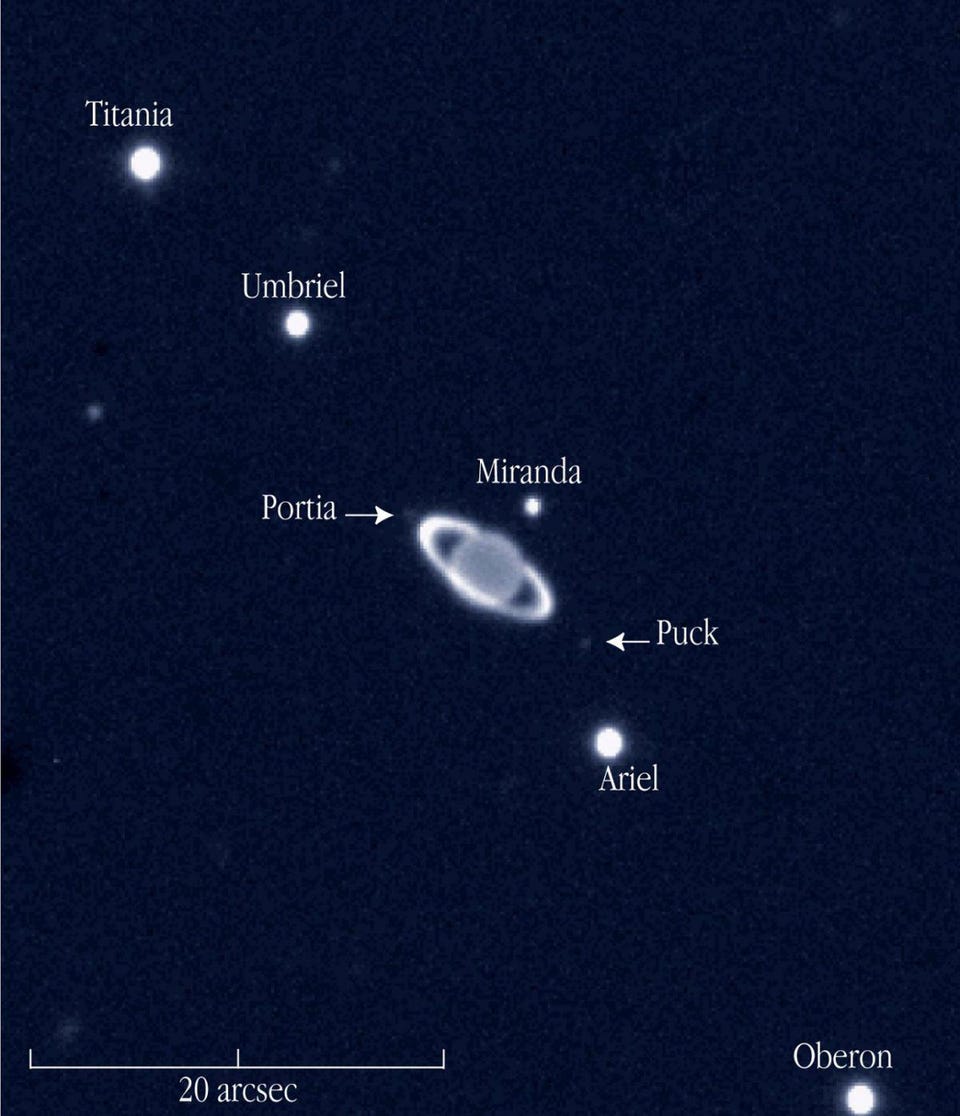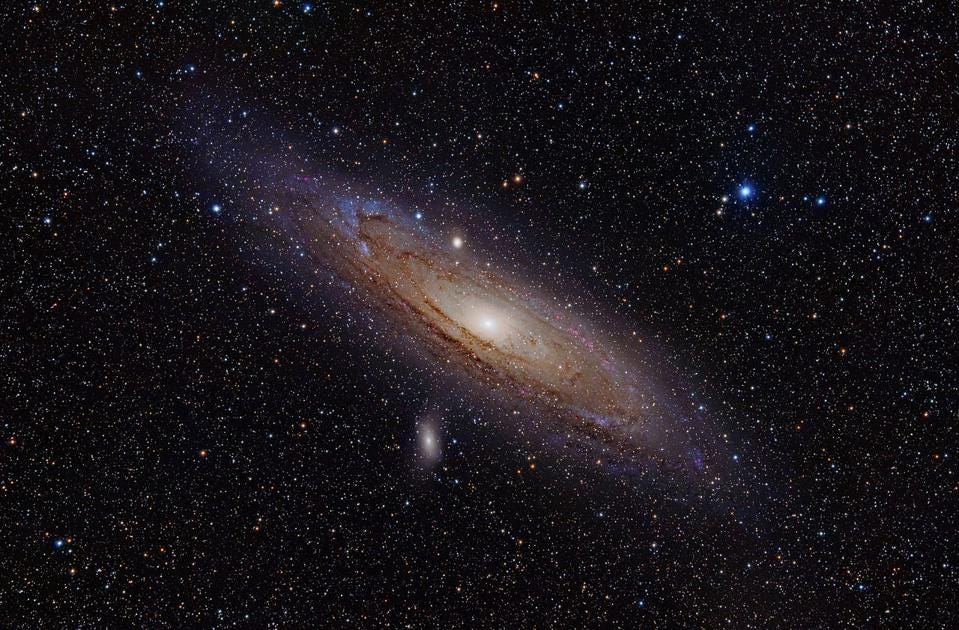 Although our modern arrays of telescopes and instruments, both on the ground and in space, can take us to incredible cosmic distances, our naked eye is much more restrictive. Nevertheless, if we consider the optimal possible observations we could take, we'd find some very impressively distant objects just by looking up.
Credit: DESI Collaboration/KPNO/NOIRLab/NSF/AURA/P. Horálek/R. Proctor
Key Takeaways
Although our modern arrays of telescopes and instruments, both on the ground and in space, can take us to incredible cosmic distances, our naked eye is much more restrictive. Nevertheless, if we consider the optimal possible observations we could take, we'd find some very impressively distant objects just by looking up.
Credit: DESI Collaboration/KPNO/NOIRLab/NSF/AURA/P. Horálek/R. Proctor
Key Takeaways
- Here on Earth, there’s a whole lot to see, observe, and explore not just in our own backyard, but across the distant Universe as well.
- However, nearly all of the more distant objects that we can see, including almost everything beyond our own galaxy, requires the use of tools, telescopes, or technologies that far surpass our naked eye’s capabilities.
- Nevertheless, there’s a remarkable set of things we can observe with just the unaided eye, including, if we chose to look in the right place at the right time, things that are surprisingly far away.
Whenever you observe an object, you aren’t viewing it in its present state.
 When one of Jupiter’s moons passes behind our Solar System’s largest planet, it falls into the planet’s shadow, becoming dark. When sunlight begins striking the moon again, we don’t see it instantly, but many minutes later: the time it takes for light to travel from that particular moon to our eyes. Here, Io re-emerges from behind Jupiter, the same phenomenon that Ole Rømer used to first measure the speed of light, while Europa and Ganymede hover on the right.
Credit: Robert J. Modic
When one of Jupiter’s moons passes behind our Solar System’s largest planet, it falls into the planet’s shadow, becoming dark. When sunlight begins striking the moon again, we don’t see it instantly, but many minutes later: the time it takes for light to travel from that particular moon to our eyes. Here, Io re-emerges from behind Jupiter, the same phenomenon that Ole Rømer used to first measure the speed of light, while Europa and Ganymede hover on the right.
Credit: Robert J. Modic
Instead, we’re held back while light travels through space.
 As shown here, the International Space Station flies over a spectacular aurora on display in Earth’s atmosphere. At its cruising altitude of around ~400 kilometers, the light we receive from the ISS here on the surface of the Earth is ~1.4 milliseconds in the past compared to events happening “now” on Earth.
Credit: NASA/International Space Station
As shown here, the International Space Station flies over a spectacular aurora on display in Earth’s atmosphere. At its cruising altitude of around ~400 kilometers, the light we receive from the ISS here on the surface of the Earth is ~1.4 milliseconds in the past compared to events happening “now” on Earth.
Credit: NASA/International Space Station
Visible artificial satellites appear as they were ~1–2 milliseconds ago.
 Whether seen with the naked eye or with modern telescopes, the light from Uranus takes approximately 159.6 minutes, or 2 hours and ~40 minutes, to reach Earth. Uranus, which has a prominent lunar system and its own rich set of rings, is the most distant naked-eye object in the Solar System.
Whether seen with the naked eye or with modern telescopes, the light from Uranus takes approximately 159.6 minutes, or 2 hours and ~40 minutes, to reach Earth. Uranus, which has a prominent lunar system and its own rich set of rings, is the most distant naked-eye object in the Solar System.Credit: ESO
The farthest naked eye Solar System object, Uranus, is 2 hours and 40 minutes in the past.
 The two sun-like stars, Alpha Centauri A and B, are located just 4.37 light years away from us and orbit one another at between the distances of Saturn and Neptune in our own solar system. Even in this Hubble image, however, they are simply oversaturated point sources; no disk can be resolved. Proxima Centauri is approximately 0.2 light years away, only 4.24 light-years from Earth.
Credit: ESA/Hubble and NASA
The two sun-like stars, Alpha Centauri A and B, are located just 4.37 light years away from us and orbit one another at between the distances of Saturn and Neptune in our own solar system. Even in this Hubble image, however, they are simply oversaturated point sources; no disk can be resolved. Proxima Centauri is approximately 0.2 light years away, only 4.24 light-years from Earth.
Credit: ESA/Hubble and NASA
The closest stars, in Alpha Centauri’s system, are ~4.3 light-years away; there, it’s early 2016 on Earth.
 Canopus, normally visible from the Southern Hemisphere, is seen here from the International Space Station. Bluish-white in color, the second brightest star in the night sky is much farther than either the brightest (Sirius, at 8.6 light-years) or third brightest (Alpha Centauri, at 4.3 light-years) star, located 310 light-years away. It is intrinsically much brighter than either one.
Credit: NASA/International Space Station Expedition 6
Canopus, normally visible from the Southern Hemisphere, is seen here from the International Space Station. Bluish-white in color, the second brightest star in the night sky is much farther than either the brightest (Sirius, at 8.6 light-years) or third brightest (Alpha Centauri, at 4.3 light-years) star, located 310 light-years away. It is intrinsically much brighter than either one.
Credit: NASA/International Space Station Expedition 6
The second brightest star, Canopus, sees a pre-Industrial Revolution Earth: 310 light-years distant.
 The three bright stars of the Summer Triangle: Vega (lower right), Deneb (top right), and Altair (at left), contain seven fascinating and easily visible deep-sky objects from our perspective. The faint outline of the plane of the Milky Way can be seen passing through this collection of stars that dominates the summer skies. Vega is a mere 26 light-years away; Deneb is about 100 times as distant at 2,615 light-years.
Credit: Kouij Ohnishi/IAU OAO
The three bright stars of the Summer Triangle: Vega (lower right), Deneb (top right), and Altair (at left), contain seven fascinating and easily visible deep-sky objects from our perspective. The faint outline of the plane of the Milky Way can be seen passing through this collection of stars that dominates the summer skies. Vega is a mere 26 light-years away; Deneb is about 100 times as distant at 2,615 light-years.
Credit: Kouij Ohnishi/IAU OAO
Deneb, anchoring the Summer Triangle, appears as it did 2615 years ago; Athenian Democracy hasn’t yet arrived.
 The Carina Nebula, shown in visible (top) and near-infrared (bottom) light, has been imaged by the Hubble Space Telescope in a series of different wavelengths, allowing these two very different views to be constructed. What appears to be a single star at the nebula’s center was identified as a binary back in 2005, and it’s led some to theorize that a third companion was responsible for triggering the supernova impostor event of the 19th century. Eta Carinae is still a compelling supernova candidate today.
Credit: NASA, ESA, and the Hubble SM4 ERO Team
The Carina Nebula, shown in visible (top) and near-infrared (bottom) light, has been imaged by the Hubble Space Telescope in a series of different wavelengths, allowing these two very different views to be constructed. What appears to be a single star at the nebula’s center was identified as a binary back in 2005, and it’s led some to theorize that a third companion was responsible for triggering the supernova impostor event of the 19th century. Eta Carinae is still a compelling supernova candidate today.
Credit: NASA, ESA, and the Hubble SM4 ERO Team
Eta Carinae, 7,500 light-years away, witnesses the Black Sea’s flooding.
 The constellation of Cassiopeia is familiar to casual skywatchers as a big “W” in the sky, but in truth the constellation contains many thousands of stars that are fainter and impossible to resolve without astronomical equipment. The farthest naked-eye star of all, V762 Cassiopeiae, can be found above the first “V” in the “W” shape, as annotated.
Credit: A. Fujii; Annotation: E. Siegel
The constellation of Cassiopeia is familiar to casual skywatchers as a big “W” in the sky, but in truth the constellation contains many thousands of stars that are fainter and impossible to resolve without astronomical equipment. The farthest naked-eye star of all, V762 Cassiopeiae, can be found above the first “V” in the “W” shape, as annotated.
Credit: A. Fujii; Annotation: E. Siegel
The oldest naked-eye starlight arrives from V762 Cassiopeiae, 16,300 years old: when humans first entered North America.
 A map of the nearest globular clusters surrounding the Milky Way’s center. A few of the globular clusters within our Milky Way, such as Omega Centauri and the great globular cluster in Hercules (Messier 13) are visible to the naked eye, but there is a visible globular cluster, Messier 3, that’s located farther away than all of the others.
A map of the nearest globular clusters surrounding the Milky Way’s center. A few of the globular clusters within our Milky Way, such as Omega Centauri and the great globular cluster in Hercules (Messier 13) are visible to the naked eye, but there is a visible globular cluster, Messier 3, that’s located farther away than all of the others.Credit: Larry McNish/RASC Calgary
Numerous visible globular star clusters are farther, with Messier 3 the most distant.
 Messier 3, a globular cluster located 33,900 light-years away, as seen through a 24″ telescope. The stars within this globular cluster are approximately 11.4 billion years old, and it can be seen with the naked eye under ideal viewing conditions.
Credit: Adam Block/Mount Lemmon SkyCenter/University of Arizona
Messier 3, a globular cluster located 33,900 light-years away, as seen through a 24″ telescope. The stars within this globular cluster are approximately 11.4 billion years old, and it can be seen with the naked eye under ideal viewing conditions.
Credit: Adam Block/Mount Lemmon SkyCenter/University of Arizona
It’s 33,900 light-years away, corresponding to the final demise of Earth’s Neanderthals.
 The location of globular cluster Messier 3, near the Big Dipper (top) and Arcturus (bottom). If you look at the star to the right of Alkaid, Cor Caroli, Messier 3 is located along the straight line connecting Cor Caroli to Arcturus. Messier 3 is the most distant naked-eye globular at an estimated 33,900 light-years away.
Credit: E. Siegel/Stellarium
The location of globular cluster Messier 3, near the Big Dipper (top) and Arcturus (bottom). If you look at the star to the right of Alkaid, Cor Caroli, Messier 3 is located along the straight line connecting Cor Caroli to Arcturus. Messier 3 is the most distant naked-eye globular at an estimated 33,900 light-years away.
Credit: E. Siegel/Stellarium
Galaxies outdistance all other visible objects.
 The largest galaxy in the Local Group, Andromeda, appears small and insignificant next to the Milky Way, but that’s because of its distance: some 2.5 million light years away. Easily visible under dark skies, it’s one of four galaxies external to our own visible with the naked eye, along with the Magellanic Clouds and Triangulum.
The largest galaxy in the Local Group, Andromeda, appears small and insignificant next to the Milky Way, but that’s because of its distance: some 2.5 million light years away. Easily visible under dark skies, it’s one of four galaxies external to our own visible with the naked eye, along with the Magellanic Clouds and Triangulum.Credit: Adam Evans/flickr
The Triangulum galaxy even bests Andromeda: 2.73 million light-years away, predating Homo Habilis.
 The Triangulum galaxy might not be as massive or impressive as ourselves or Andromeda, but it’s the farthest object from Earth visible with the naked eye, and the third largest galaxy in our local group. At 2.73 million light-years away, they would not be able to find any evidence for the genus ‘Homo’ on Earth.
The Triangulum galaxy might not be as massive or impressive as ourselves or Andromeda, but it’s the farthest object from Earth visible with the naked eye, and the third largest galaxy in our local group. At 2.73 million light-years away, they would not be able to find any evidence for the genus ‘Homo’ on Earth.Credit: Optical: Warren Keller; X-ray: NASA/CXC/SAO/P. Plucinsky et al.
Only temporary, transient events are farther.
 This dual image shows the emission of GRB 080319B, imaged by Swift’s X-ray Telescope (L) and, later, followed-up by the Optical/Ultraviolet Telescope (R). This was the brightest gamma-ray burst ever recorded at the time, and was so bright that, for about 30 seconds on March 19, 2008, it was visible to the naked human eye.
This dual image shows the emission of GRB 080319B, imaged by Swift’s X-ray Telescope (L) and, later, followed-up by the Optical/Ultraviolet Telescope (R). This was the brightest gamma-ray burst ever recorded at the time, and was so bright that, for about 30 seconds on March 19, 2008, it was visible to the naked human eye.Credit: NASA/Swift/Stefan Immler, et al.
Gamma-ray burst GRB 080319B was visible for ~30 seconds on March 19, 2008.
 The distant galaxy EGC 1305123, seen in optical light (L) and ionized carbon monoxide (R), as imaged by Hubble. This galaxy is comparable, in many ways, to an early version of the Milky Way, and its light comes to us from about ~8 billion years ago, comparable to the most distant gamma-ray burst visible with the naked eye. This galaxy, itself, is most definitely not visible to the naked eye, however.
Credit: L.J. Tacconi et al., Nature, 2010
The distant galaxy EGC 1305123, seen in optical light (L) and ionized carbon monoxide (R), as imaged by Hubble. This galaxy is comparable, in many ways, to an early version of the Milky Way, and its light comes to us from about ~8 billion years ago, comparable to the most distant gamma-ray burst visible with the naked eye. This galaxy, itself, is most definitely not visible to the naked eye, however.
Credit: L.J. Tacconi et al., Nature, 2010
7.5 billion light-years away, its light predates Earth’s existence by ~3 billion years.
 An illustration of the young stellar system Epsilon Eridani, somewhat analogous to our own Solar System, just a few hundred million years after it began forming planets. The Earth and Sun formed roughly 4.5–4.6 billion years ago; an object whose light must travel for 7.5 billion years before reaching our eyes would have no inkling of our planet’s existence for another ~3 billion years.
An illustration of the young stellar system Epsilon Eridani, somewhat analogous to our own Solar System, just a few hundred million years after it began forming planets. The Earth and Sun formed roughly 4.5–4.6 billion years ago; an object whose light must travel for 7.5 billion years before reaching our eyes would have no inkling of our planet’s existence for another ~3 billion years.Credit: NASA/SOFIA/Lynette Cook
Mostly Mute Monday tells an astronomical story in images, visuals, and no more than 200 words.
This article was first published in May of 2021. It was updated in November of 2025.
Tags Space & Astrophysics In this article Space & Astrophysics Sign up for the Starts With a Bang newsletter Travel the universe with Dr. Ethan Siegel as he answers the biggest questions of all. Subscribe



